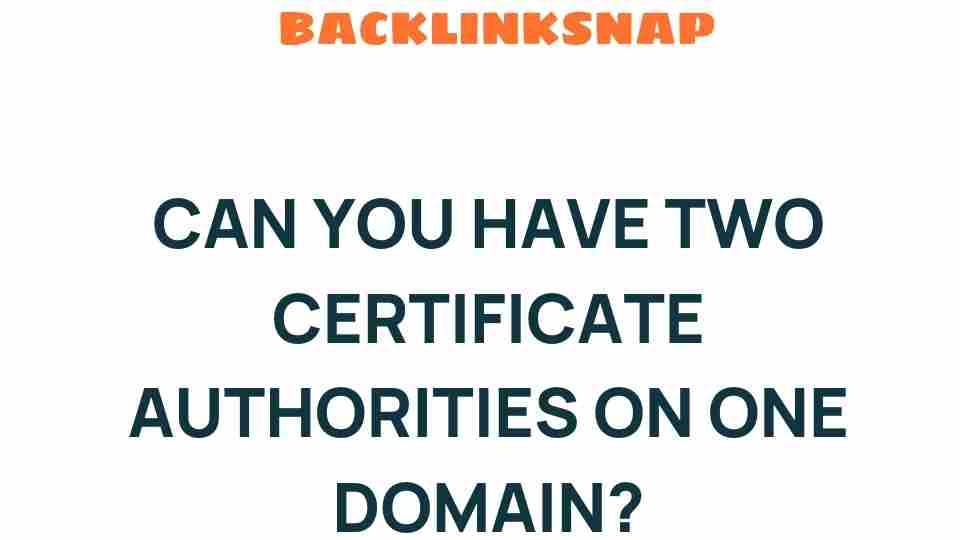Exploring the Possibility: Can You Have Two Certificate Authorities on One Domain?
In the evolving landscape of cybersecurity, the importance of certificate authorities (CAs) cannot be overstated. With the proliferation of digital transactions and data exchanges, the need for reliable SSL certificates to secure these interactions has become paramount. However, a question that often arises among webmasters and cybersecurity professionals is whether it’s feasible to have two certificate authorities on one domain. In this article, we’ll delve into this topic, exploring the implications for domain security, website encryption, and overall internet trust.
Understanding Certificate Authorities
Before we dive deeper, let’s clarify what a certificate authority is. A CA is a trusted entity that issues digital certificates. These certificates are essential components of securing communications over the internet. They authenticate the identities of websites, ensuring that data exchanged between a user’s browser and the server remains encrypted. The most common type of certificate that CAs issue is the SSL certificate, which is crucial for enabling HTTPS connections.
Essentially, when you visit a website that uses HTTPS, your browser checks the SSL certificate presented by the server against a list of trusted CAs. If the certificate is valid and the CA is trusted, your browser establishes a secure connection. This process fosters internet trust and is foundational to cybersecurity.
Can You Use Two Certificate Authorities on One Domain?
The short answer to the question is yes, you can technically use two different certificate authorities for a single domain. However, there are significant caveats and considerations to bear in mind.
When deploying SSL certificates from multiple CAs for the same domain, one must be cautious about the configuration and the potential for conflicts. Typically, a single domain will use one primary SSL certificate to establish trust. However, if you need to use certificates from two different CAs, it’s often done in the following scenarios:
- Subdomains: You can have different CAs for different subdomains. For example,
www.example.comcould use a certificate from CA1, whileapi.example.comutilizes a certificate from CA2. - Certificate Types: You might have a wildcard certificate from one CA while also using a specific certificate from another CA for certain paths or services within the domain.
- Transitioning to a New CA: During a migration period from one CA to another, both certificates may be valid for a time. However, this should be managed carefully to avoid security issues.
Implications for Domain Security
While it’s possible to have two certificate authorities on one domain, doing so can complicate domain management and impact overall security. Here are some implications to consider:
- Complexity: Managing multiple certificates from different CAs increases the complexity of your SSL management. You must ensure that both certificates are up to date, correctly configured, and compatible with your server environment.
- Trust Issues: If one of the CAs is less trusted or has a history of vulnerabilities, it can undermine the security of your entire domain. Users may receive warnings if their browsers do not recognize one of the CAs.
- Performance Overhead: Multiple certificates can lead to increased latency during the SSL handshake process, potentially impacting user experience.
Best Practices for Using Multiple CAs
If you find yourself in a situation where you must use two certificate authorities on one domain, consider these best practices:
- Choose Trusted CAs: Ensure that both CAs are reputable and widely trusted. Research their history and reliability.
- Document Configurations: Keep clear documentation of your SSL configurations to simplify management and troubleshooting.
- Monitor Certificate Status: Regularly check the status of your certificates and set reminders for renewal dates to prevent lapses in security.
- Implement HSTS: Utilize HTTP Strict Transport Security (HSTS) to enforce secure connections, mitigating potential risks associated with misconfigured certificates.
Conclusion
In conclusion, while you can technically have two certificate authorities on one domain, it’s not without its challenges and risks. The complexity of managing multiple SSL certificates can pose significant hurdles, potentially affecting your domain’s security and user trust. It’s crucial to evaluate whether the benefits of using multiple CAs outweigh the potential complications.
As cybersecurity continues to evolve, understanding the role of certificate authorities and how to effectively manage them is essential for maintaining a secure online presence. Always prioritize trusted CAs and adhere to best practices to ensure that your website remains a safe haven for users.
FAQs
- What is a certificate authority? A certificate authority is a trusted organization that issues digital certificates to verify the identity of entities on the internet.
- Can I have multiple SSL certificates for one domain? Yes, you can have multiple SSL certificates for one domain, typically for subdomains or during transitions between CAs.
- What happens if one CA becomes untrusted? If one CA becomes untrusted, it could lead to security warnings for users accessing your domain, potentially damaging your reputation.
- How can I manage multiple SSL certificates effectively? Document your configurations, choose trusted CAs, monitor certificate status, and implement HSTS to enhance security.
- Is it necessary to use multiple CAs? It’s not necessary for most users, but specific scenarios may warrant it, such as different subdomains requiring unique certificates.
- What is HSTS? HSTS, or HTTP Strict Transport Security, is a web security policy mechanism that helps protect websites against man-in-the-middle attacks.
For further insights into domain management and SSL certificates, you might want to check out this comprehensive resource on SSL best practices. Understanding the interplay between certificate authorities and your domain is crucial to ensuring a secure and trustworthy online presence.
This article is in the category Digital Marketing and created by BacklinkSnap Team




